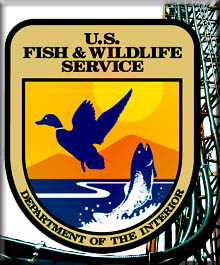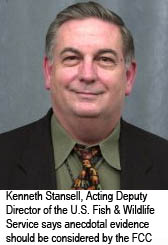|
Fish and Wildlife Service's recommendations could reshape tower industry if accepted by FCC
February 6, 2007 - Although the U.S. Fish and Wildlife Service is of the opinion that some of the recent actions of the Federal Communications Commission in respect to communication towers tread upon FWS authority, the bureau is championing the FCC to move forward with changes that will dramatically reshape the industry. 
As expected, say tower industry observers, the FWS is in agreement with many of the FCC's proposed initiatives, many of which have been lobbied for by the wildlife service agency during the past seven years.
In a February 2 letter to the FCC , Acting Deputy Director Kenneth Stansell outlined the service's concerns and suggestions as they addressed migratory bird deaths caused by collisions with communications towers throughout the nation.
The FWS provided their comments to the FCC's Notice of Public Rulemaking (WT Docket No 03-187 ) request In the Matter of Effects of Communications Towers on Migratory Birds, questioning whether the deaths of birds caused unintentionally, as by the operation of a communication tower, can make a regulatory commission like the FCC liable?
FWS recommendations
In addition, they recommended that:
-- Anecdotal evidence may be the best biological information available if robust studies have not been conducted.
-- Medium intensity white strobe lights for nighttime use is to be considered the preferred system over red obstruction lighting systems to the maximum extent possible without compromising aircraft navigation safety.
-- If medium intensity white strobe lights cannot be used, such as when a local zoning ordinance prohibits it, red strobe lighting should be required.
-- Retrofitting of towers to the new lamping systems should be done when tower broadcast licenses expire or when incandescent systems burn out. All towers must be retrofitted within no longer than five years following approval of the regulation.
-- New towers, where practicable, should be less than 200-feet above ground level, be of monopole or lattice design, contain no guy wires or lights, and restrict taller towers that have to be built from being guyed.
-- Provide limited use and more studies on the marking and painting of guy wires.
-- Tower developers must complete a site evaluation form and provide it to the U.S. Fish and Wildlife Service Ecological Services Field Office having jurisdiction for the area in which the tower is proposed to be located as part of the NEPA review process.
A frequent criticism raised in previous CTIA - The Wireless Association survey responses concerning the FWS lighting guidelines is that their recommendations do not appear to be based on scientific research, but rather on anecdotal evidence. The FWS's recent comments appear to acknowledge that new studies have not been completed and anecdotal information should be acceptable to the FCC.
Although Acting Deputy Director Stansell's comments noted that building windows are estimated to kill from 97 to 980 million birds per year, they said that currently it may be very difficult to seriously reduce window strike collisions. Tower industry professionals are quick to point out the noticeably absent advocacy of the FWS to initiate studies on buildings in order to capture a more definable amount of deaths as well as identify solutions to prevent the bird kills such as the methods they have proposed to the FCC for tower owners.
A study often cited in avian fatalities is the Klem Report, which estimated that between one and ten birds were killed per building, per year; however, the study does not make any attempt to distinguish the difference in height and size of a commercial office building and a house.
Tower owners believe that conclusions from limited regional studies should not be used to draw a specific conclusion until additional research examines a larger range of tower heights in different geographic and topographic locations.
A request by avian and tower industry groups to obtain additional time to address the complex issues has been approved by the Federal Communications Commissioning, extending the agency's public comment deadline until April 23, 2007.
The FWS was not an author of the joint request that included: PCIA - The Wireless Infrastructure Association, National Association of Broadcasters, CTIA - The Wireless Association, National Association of Tower Erectors, American Bird Conservancy, Environmental Defense, Defenders of Wildlife and National Audubon.
Members of the tower coalition are carefully reviewing the FWS's comments and will address some of them in their initial response to the NPRM.
Some responders to an issue will provide their comments at the last moment in order to keep others from countering their views during the submission period, preferring the opposition to hastily prepare their reply comments during the 30-day window provided for individuals and associations to refute initial comments that were provided through April 23.
Comments sent to WirelessEstimator.com and posted in its forum will be provided to the Commission prior to their deadline.
After reviewing all of the comments to the NPRM, the FCC may also choose to issue a Further Notice of Proposed Rulemaking (FNPRM) regarding specific issues raised in comments. The FNPRM provides an opportunity for interested individuals and organizations to comment further on a related or specific proposal.
After considering comments to a Notice of Proposed Rulemaking (or Further Notice of Proposed Rulemaking), the FCC issues a Report and Order. The R&O may develop new rules, amend existing rules or make a decision not to do so.
Summaries of the R&O are published in the Federal Register. The Federal Register summary will identify when a rule change will become effective.
|